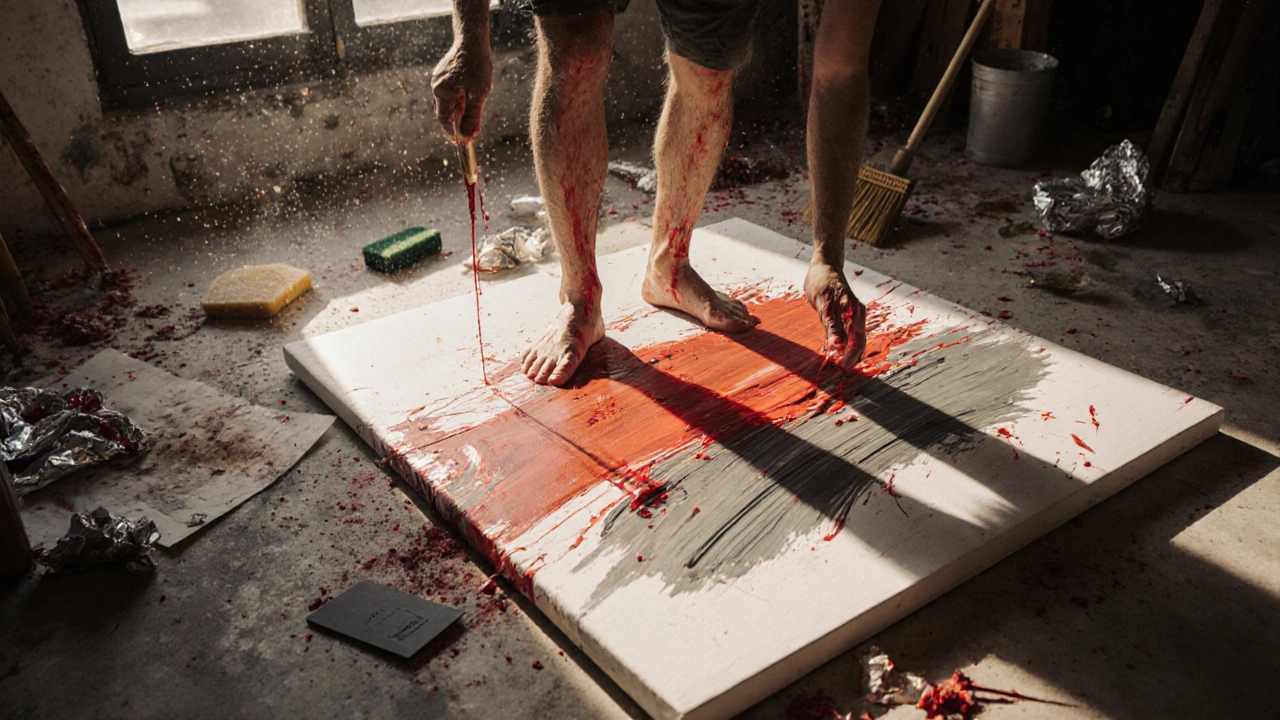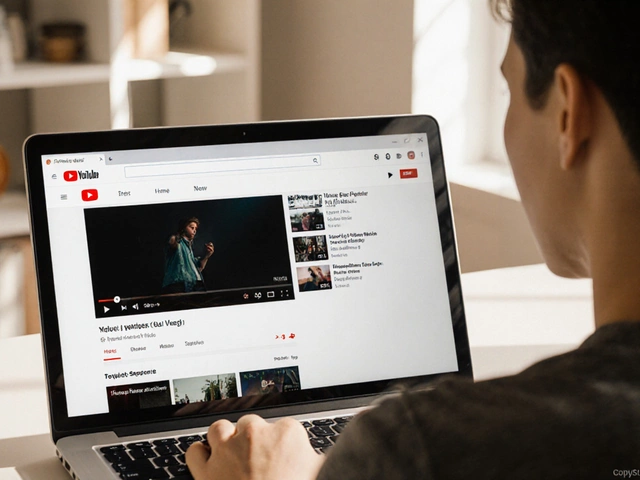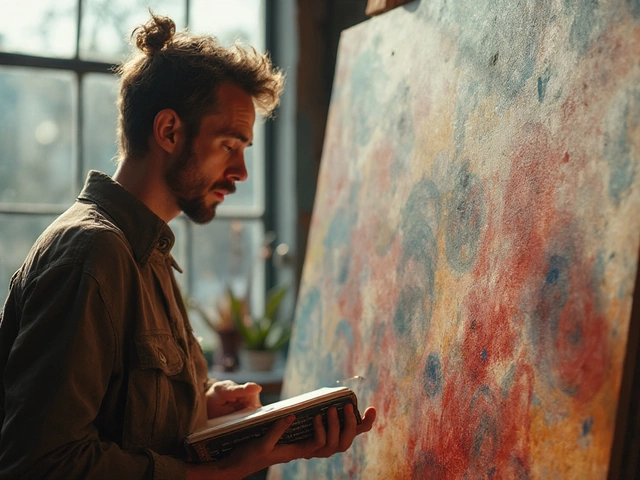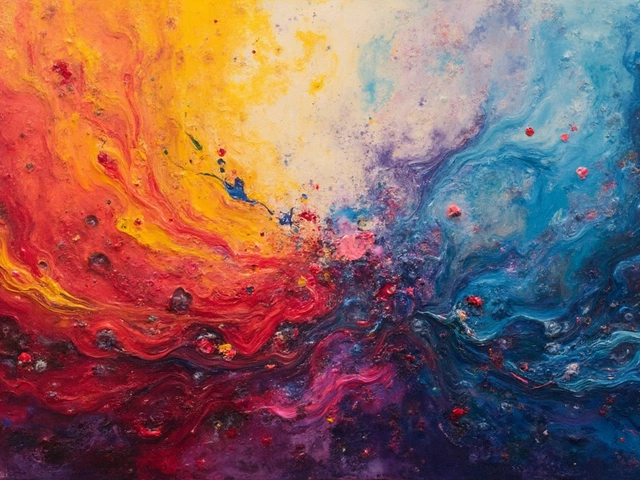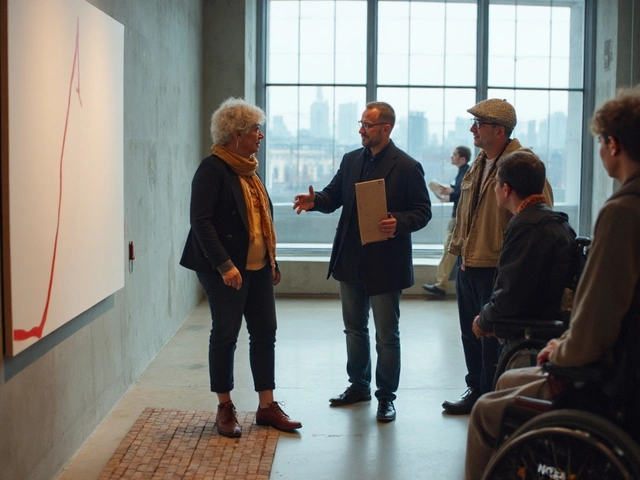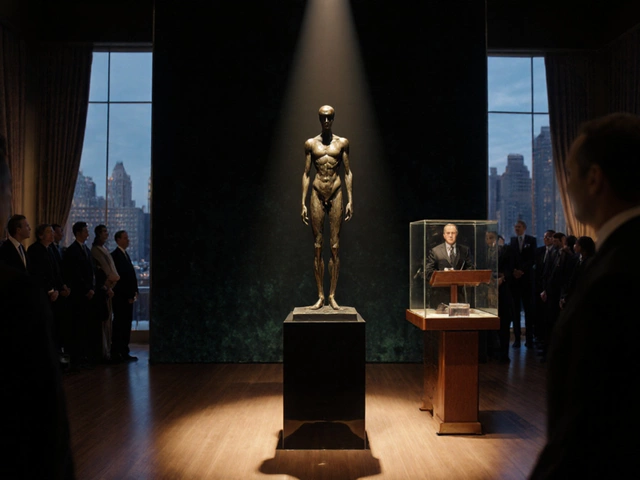Mistake Transformator
Describe Your Accidental Mark
What happened? A drip? A smudge? A color bleed? Be specific!
Your Creative Transformation
Describe your accidental mark above to see how to transform it into intentional art.
Abstract art doesn’t need to make sense. That’s the point. If you’re waiting for permission to start-stop waiting. You don’t need to know how to draw a tree or paint a face to make powerful abstract art. You just need to move, feel, and let go.
Forget the Rules, Start with Materials
You don’t need expensive supplies. Grab what’s lying around: old canvases, cardboard, acrylic paint from last summer, a sponge, a credit card, or even a stick. Abstract art thrives on what’s available, not what’s perfect. I’ve seen stunning pieces made with house paint, coffee stains, and torn newspaper. The material doesn’t define the art-it’s what you do with it.Start with three colors. Not six. Not ten. Three. Pick one warm, one cool, and one neutral. Red, blue, and gray. Yellow, black, and white. It forces you to focus on contrast, texture, and movement instead of color mixing. Too many colors? That’s how beginners drown their energy in noise.
Let Your Body Lead, Not Your Brain
Most people try to plan abstract art. They sketch. They think. They worry if it’s "good." That kills it. Abstract art isn’t made in the mind-it’s made in the body.Stand up. Put the canvas on the floor. Dip a brush in paint. Don’t think about what you’re doing. Just move. Swipe. Drip. Smear. Spatter. Let your arms swing. Let your wrist twist. Let your whole body react to the rhythm of your breath or music. Play something loud. Or silent. Either works.
This isn’t random. It’s intuitive. Your body remembers emotions you can’t name. That tension in your shoulders? Let it become a jagged line. That calm you felt after walking the beach? Let it become a soft wash of color. Abstract art is emotion made visible.
Use Tools You Didn’t Know You Had
A brush is just one option. Try these:- A plastic comb dragged through wet paint
- Scrunched-up aluminum foil pressed onto the surface
- A spray bottle for misty layers
- A credit card to scrape and reveal hidden colors underneath
- Your fingers-yes, your fingers
Each tool creates a different kind of mark. A comb gives you rhythm. Foil gives you texture. Fingers give you intimacy. You’re not painting a picture-you’re building a record of motion, pressure, and time.
I once watched a student use a broken broom handle to drag thick paint across a 6-foot canvas. The result looked like wind moving through tall grass. No one taught her how. She just tried it.
Layer Like a Geologist
Abstract art isn’t built in one go. It’s built in layers-like rock strata. Start with a base. Let it dry. Then add something that contradicts it. A dark line over a light wash. A splash of red over gray. A thick ridge of paint over a smooth field.Let some layers show through. Let others hide. That’s where depth comes from. It’s not about covering mistakes. It’s about revealing history.
Wait for each layer to dry. Rushing? You’ll muddy the colors. Patience isn’t boring here-it’s the secret ingredient. I’ve seen paintings that took three weeks to finish because the artist kept adding, waiting, stepping back, and then adding again.
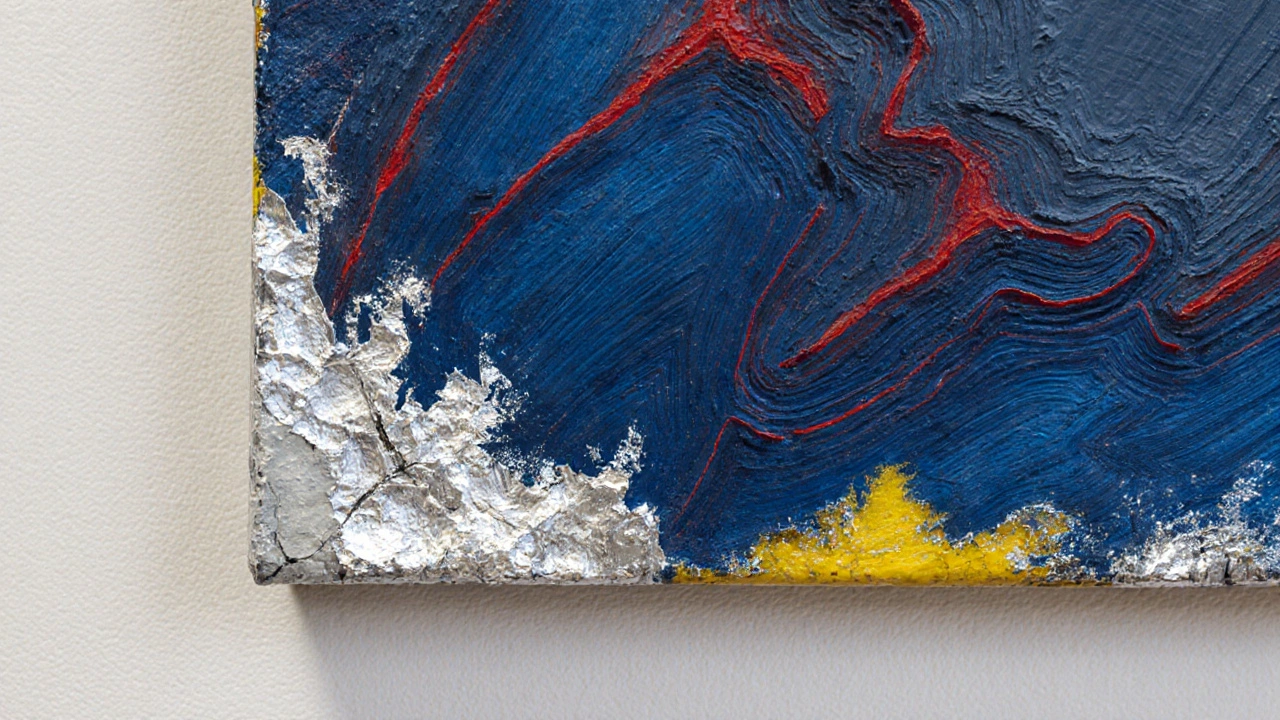
Embrace the "Mistakes"
You spill paint? Good. You go too far with a color? Better. You meant to make a curve and got a jagged line? Perfect.Abstract art doesn’t have a right answer. There’s no "correct" shape or balance. What looks like an accident to you might be the most compelling part of the piece to someone else.
Instead of wiping it out, ask: "What if I build on this?" Turn that blob into a focal point. Let that streak become a path. Let the "mistake" lead you somewhere you didn’t plan. That’s where the magic happens.
Step Back. Often.
Stand six feet away. Walk around the piece. Look at it upside down. Take a photo with your phone and view it small on the screen. Your eyes get used to what’s right in front of you. Distance reveals what your brain ignores.Is there one spot that pulls your eye? That’s your anchor. Is the piece too busy? Cut back. Less is more. A single dark mark on a pale field can hold more weight than ten busy strokes.
When you’re unsure if it’s done, stop. Walk away. Come back tomorrow. If it still feels alive, it’s finished. If it feels dead, add one thing. Then stop again.
Don’t Compare. Don’t Seek Approval
You’ll see Kandinsky. Pollock. Rothko. Their work is iconic. But comparing your first piece to theirs is like comparing a toddler’s first steps to an Olympic sprinter’s.Abstract art isn’t about being famous. It’s about being honest. Your piece doesn’t need to look like a masterpiece. It needs to feel like you.
I’ve had students cry after finishing their first abstract painting-not because it was good, but because they finally felt free to make something that didn’t have to be perfect. That’s the real win.
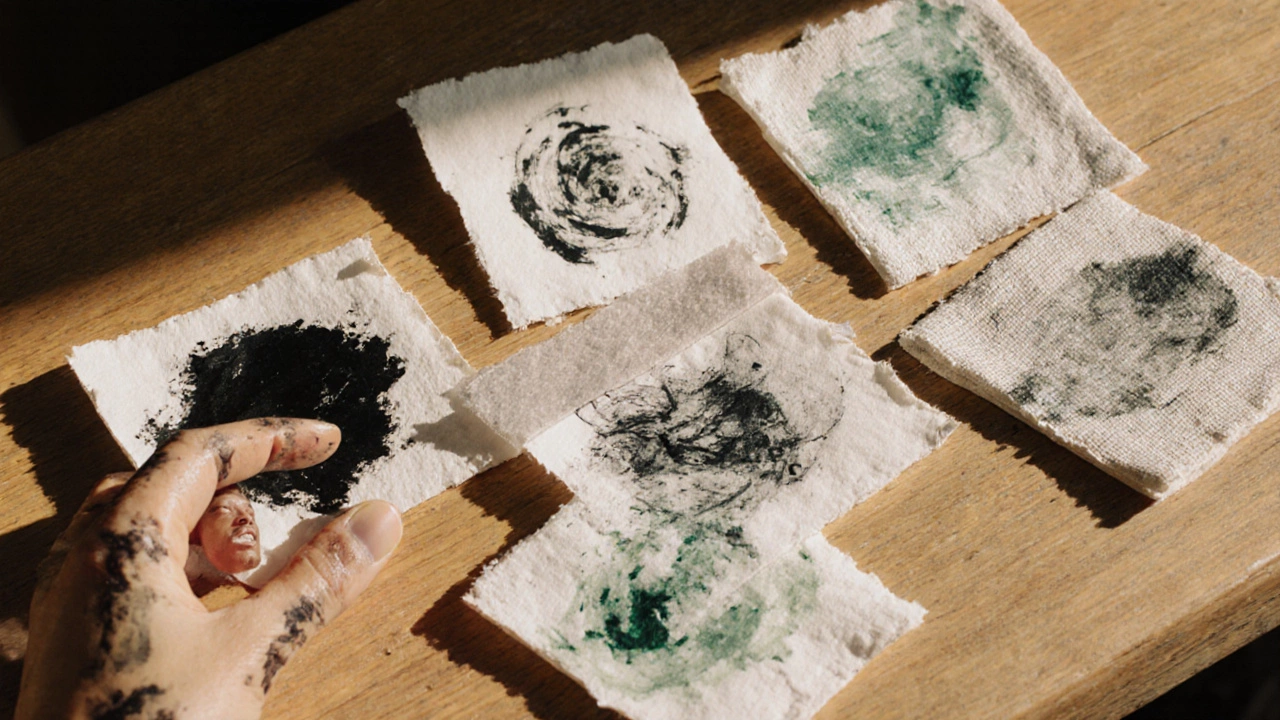
What to Do When You’re Stuck
If you sit down and nothing comes:- Put on a song you hate. Paint to it.
- Use only one color. Just black. Or just white.
- Paint with your non-dominant hand.
- Close your eyes and paint for two minutes.
- Use a different surface-a piece of glass, a wooden board, fabric.
These aren’t tricks. They’re ways to break the habit of thinking. Abstract art isn’t about skill. It’s about surrender.
Keep a Visual Journal
Don’t just make one big painting. Make small ones. 5x7 inches. On paper. On scraps. Every day for a week. No pressure. No goal. Just record what you felt.After seven days, lay them out. Look at them together. You’ll see patterns. A color you keep returning to. A motion you repeat. A mood you didn’t know you were carrying. That’s your voice.
That’s your abstract art.
It’s Not About Talent. It’s About Trust.
You don’t need to be "artistic." You just need to be willing to try something that doesn’t have a right answer. Abstract art asks you to trust your gut, your hands, your chaos. It asks you to accept that beauty doesn’t always look like something you recognize.Start small. Start messy. Start now. The world doesn’t need another perfect painting. It needs more honest ones.
Do I need to know how to draw to create abstract art?
No. Abstract art doesn’t rely on realistic drawing skills. It’s about expressing emotion, movement, and texture-not replicating what you see. Many artists who make powerful abstract work never learned to draw in the traditional sense. What matters is your willingness to experiment and let go of control.
What’s the difference between abstract art and random splatters?
Random splatters lack intention. Abstract art, even when it looks chaotic, is built with awareness-of color, balance, rhythm, and emotion. You might not plan the outcome, but you’re making choices as you go: where to apply paint, how much to layer, when to stop. That decision-making, even if intuitive, is what transforms splatters into art.
Can I use digital tools to make abstract art?
Yes. Digital tools like Procreate, Photoshop, or even mobile apps can be excellent for abstract work. They let you undo, layer, and experiment quickly. But don’t let the tools replace the feeling. The same principles apply: move intuitively, embrace mistakes, and focus on emotion over perfection. Digital doesn’t mean less real-it just means different materials.
How do I know when my abstract piece is finished?
When adding more feels like clutter, not contribution. Step back. Look at it from across the room. Does it feel complete, or does it feel like it’s begging for more? If you’re unsure, wait 24 hours. Often, the answer becomes clear. Trust your gut-not your inner critic. A finished piece doesn’t need to be polished. It needs to feel true.
What if people say my abstract art "looks like a mess"?
That’s not a judgment on your art-it’s a judgment on their expectations. Abstract art isn’t meant to be understood immediately. It’s meant to be felt. If someone expects a landscape or a portrait, they’re not looking at abstract art-they’re looking for something else. Keep making what feels right to you. Your work doesn’t need their approval to be valid.
